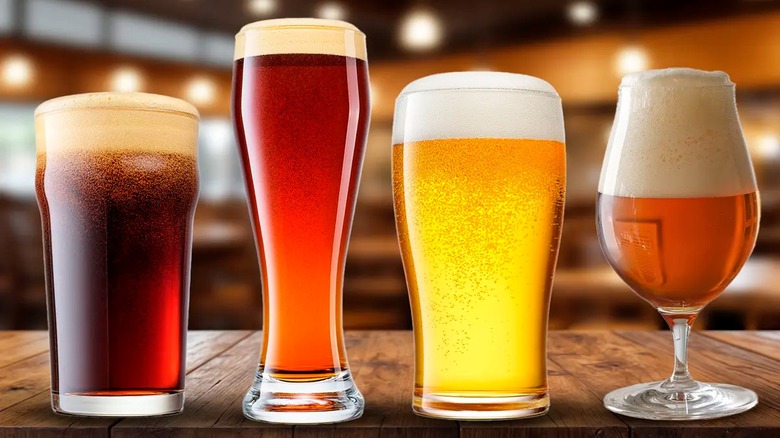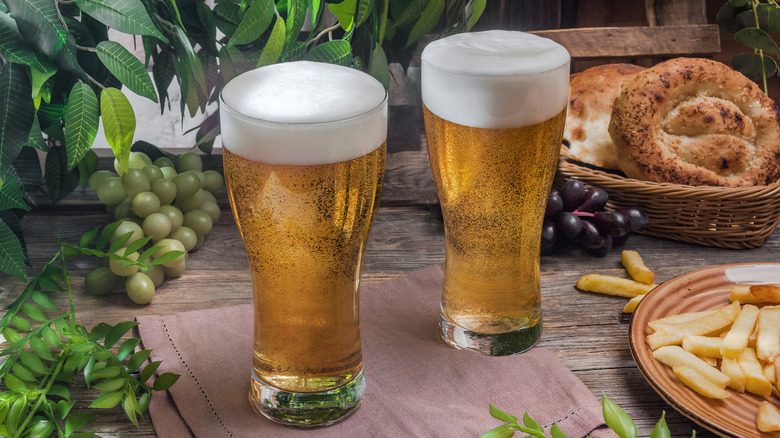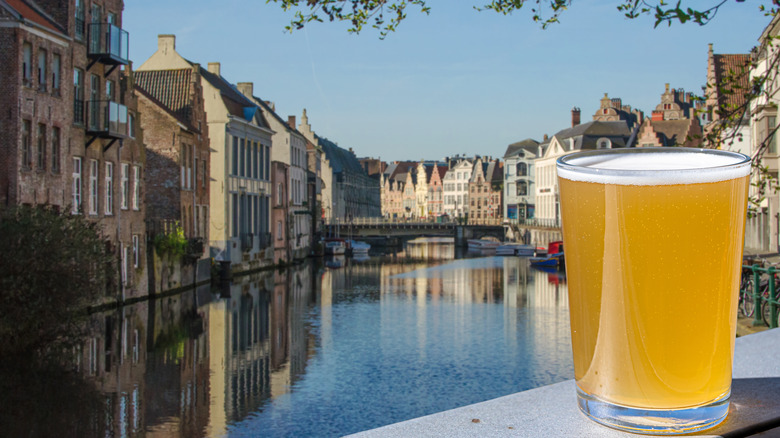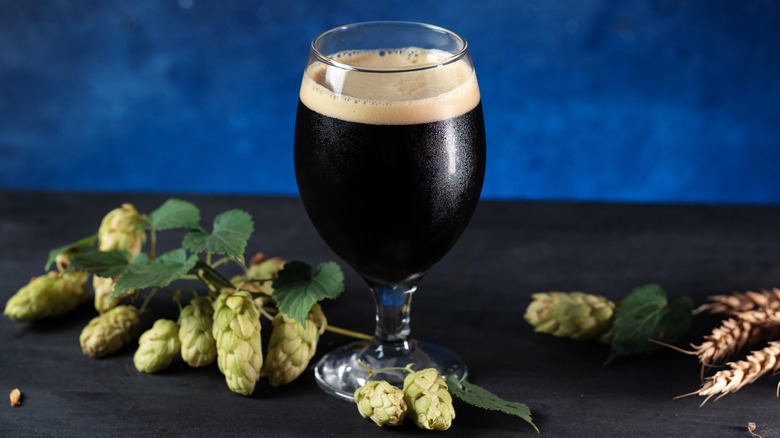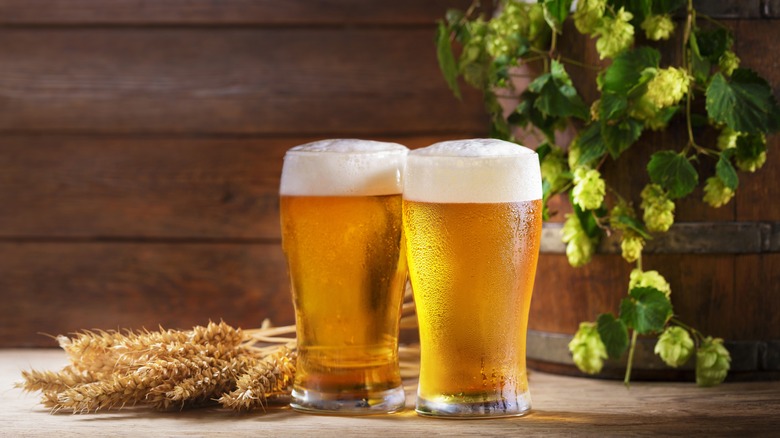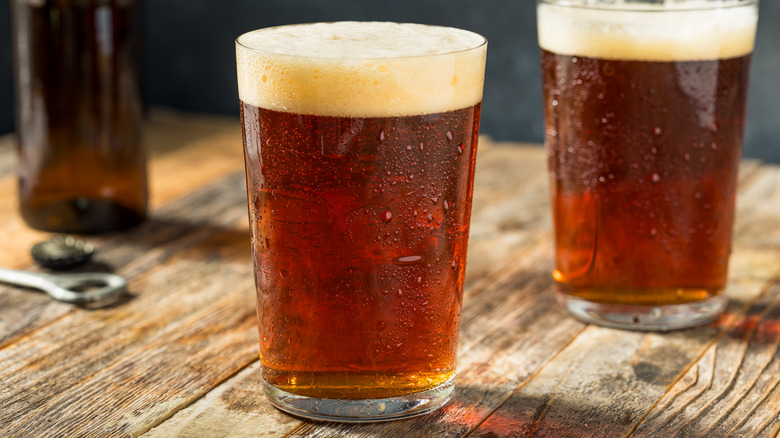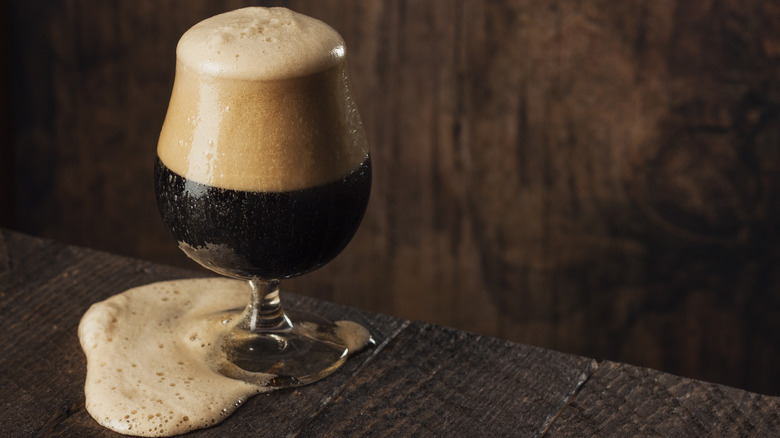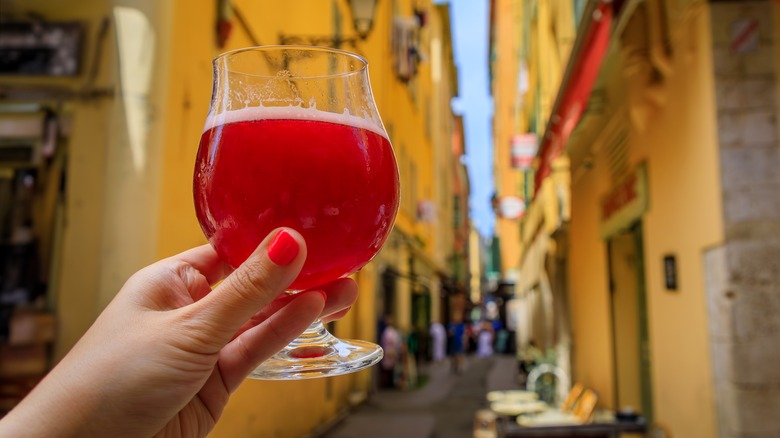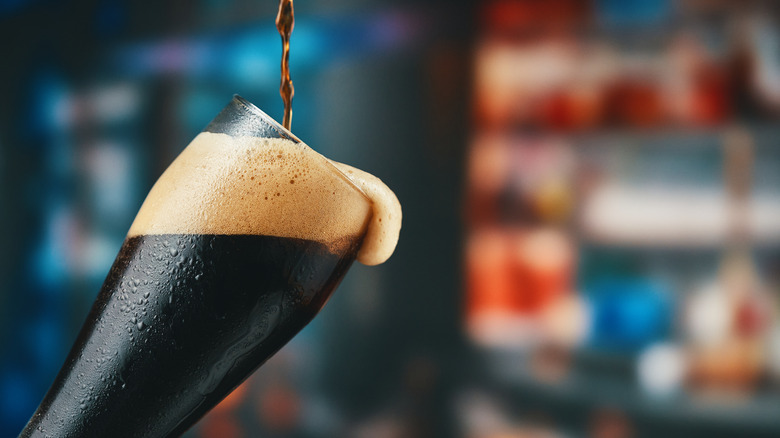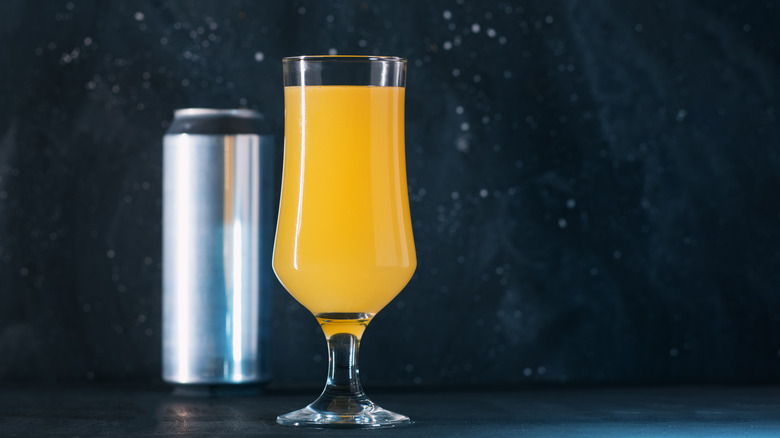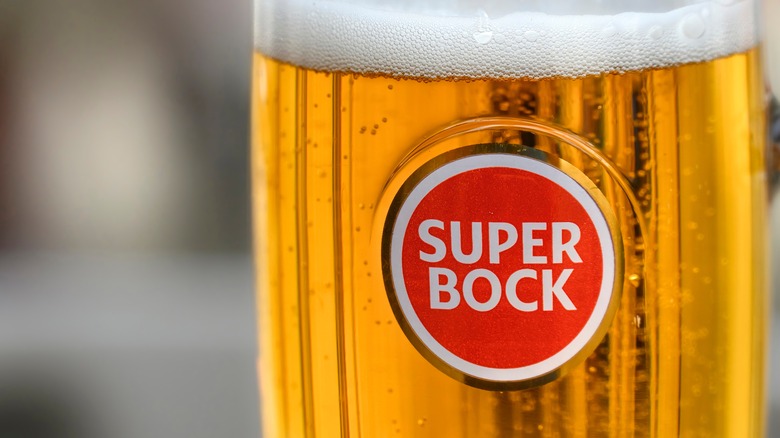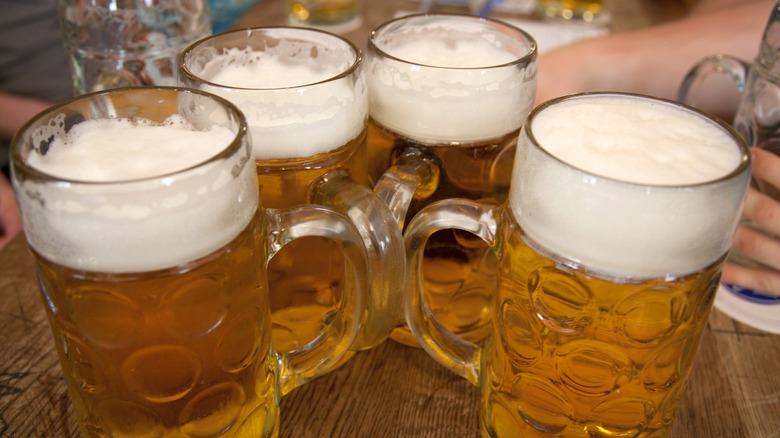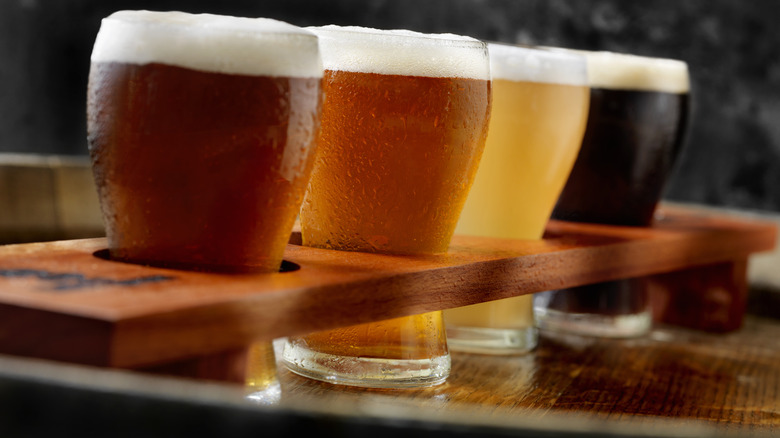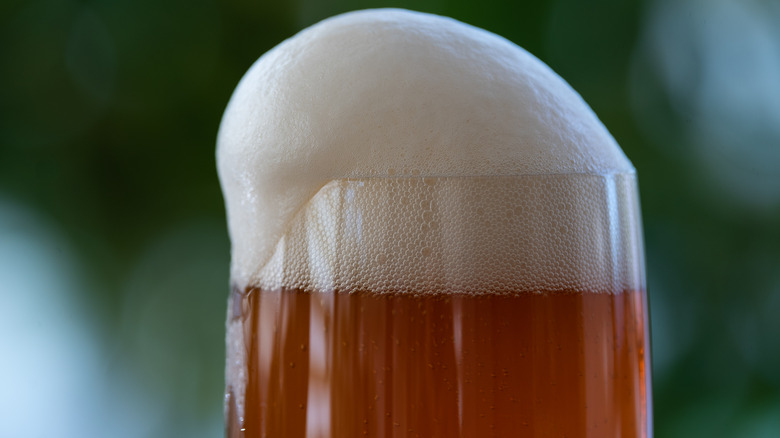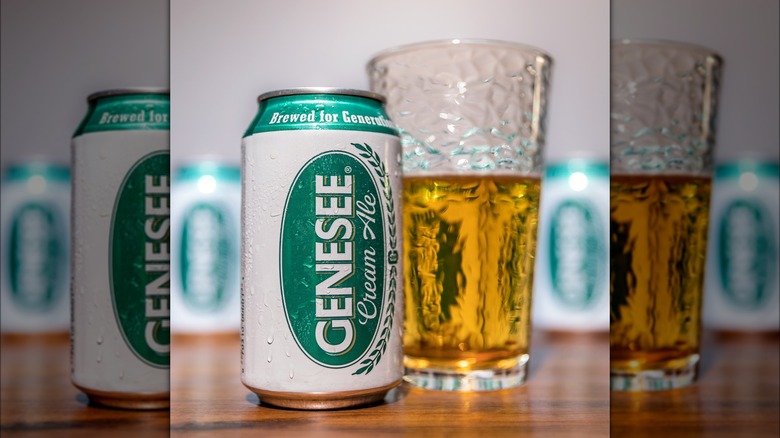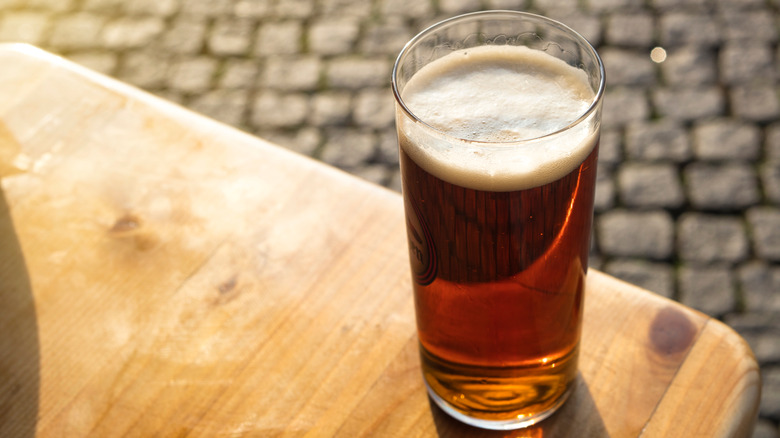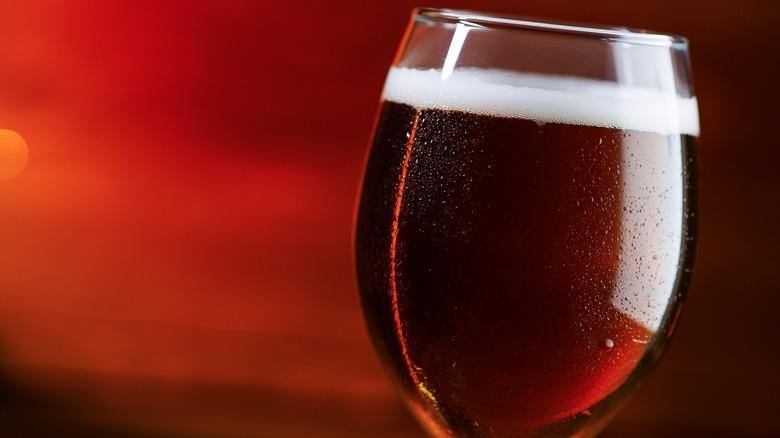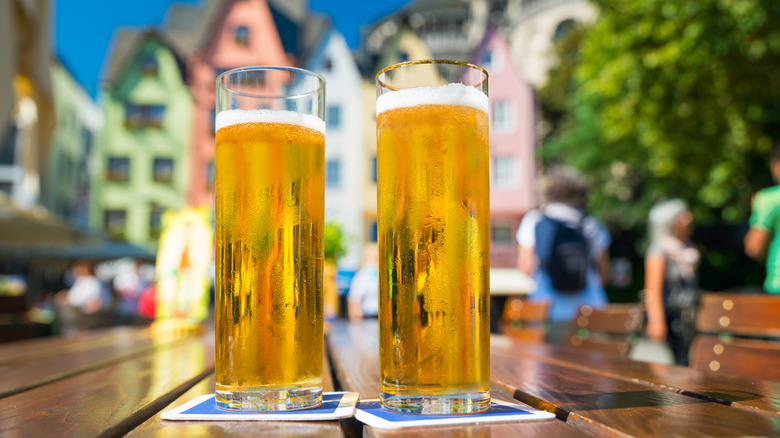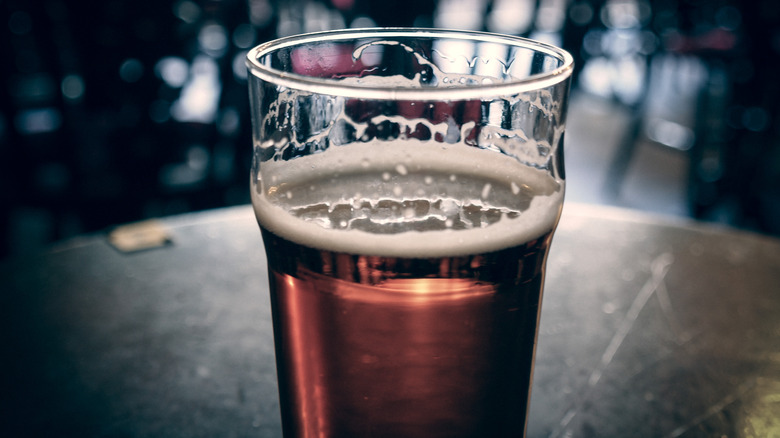20 Types Of Beer Explained
If you're heading to the store to pick up some beer to enjoy at the end of a long week, what do you reach for? IPA, stout, pilsner, or something else? Turns out, choosing a good beer is more complicated than you'd think. Let's talk about beer styles, and maybe we can introduce you to your new favorite.
First, the basics. Beer is generally divided into two main categories: lager and ale. Although there are outliers and hybrids, they're generally defined by the type of yeast that's used in the fermentation process, the temperature at which they're fermented (with ales being fermented at higher temperatures), and taste. That varies, too, but a good thing to keep in mind is that lagers are lighter, so those hoppy, malty notes will generally be easier to identify on the palate, while heavier ales are going to give you a more complex flavor profile. What about stouts? They're actually part of the ale family, and they're a great example of the more complex flavor profiles that go with an ale. Stouts are a style of beer that's thicker, heavier, and darker in color; although, there's just as much variety here as there is in other types of lagers and ales.
That's pretty straightforward so far, right? So, keeping in mind the differences between those general styles, let's dive into the many different types of beer.
Pilsner
All pilsners are lagers, but what sets these beers apart is that they tend to have a bolder flavor profile than many other lagers. They were something of a happy accident, created in 1842 when a Bavarian brewer decided to increase the hops used in a batch of spoiled lager in order to save and preserve it. Now, most pilsners are made using noble hops, which are varieties that have been grown in Europe for generations and impart a citrus and floral flavor.
There are a few different types of pilsners: German pilsners are bold and lean toward the bitter side of things, while Czech (or Bohemian) pilsners are almost bready. Meanwhile, Belgian pilsners are lightly flavored, and American pilsners are even more mild.
Belgian styles
When it comes to extra-special beers, you may hear talk of an ultra-rare Trappist beer that's still made in a 19th-century monastery. But what makes Belgian beers so special is that they often fall well outside categories, as the history of Belgian brewing is more about creativity than conforming to styles. When you pick up a Belgian beer, it's going to be complex and flavorful.
Brewed within the walls of one of the few remaining Trappist monasteries, Trappist beers are still brewed by Trappist Order monks. But not all Belgian beers are Trappist beers. Then, there's Abbey beers. These don't have the same monastic origins as Trappist beers, but they are similar in style and there are a few different types. Belgian singles (which are also called enkels or monk's beers) have a lower alcohol content than the brown, often chocolatey dubbels and the golden and hop-heavy tripels. The Grand Cru, or quadruple style, contains up to 12% alcohol by volume (ABV), and connoisseurs often name these as among the best beers in the world.
Imperial stout
If a stout is a rich, thick beer that's characterized by strong flavors and a dark color, what's an Imperial stout? Just like that regal name implies, you can think of these beers as the ultimate stout: They're known for having a much stronger, more complex flavor, a thicker texture, and higher alcohol content, which comes in part from a longer aging process, more grains, more hops, and more yeast.
The name is no coincidence, either. This particular type of beer was initially called Russian Imperial stout, as it was specially designed and created in England to be able to withstand export to the Empress of Russia, Catherine the Great, who ruled from 1762 to 1796.
Wheat beer
The grains used in alcohol production have a major impact on the final product. It's why we often talk about things like the difference between high-wheat and high-rye bourbons, and the same idea applies to beer. Wheat beers are, of course, brewed by using wheat (as opposed to something like barley), and here's a fun fact: Wheat beers have been around for more than 8,000 years.
Today, there are a number of different wheat beer styles, but they all tend to have some things in common. They're almost always creamy yet cloudy; they're generally dry instead of sweet or bitter; and if you know someone who wants to get into exploring different types of beers, you're not going to go wrong with a wheat beer. It's more accessible than a heavy stout or a hoppy IPA, and it's also pretty ideal for sipping on a hot summer day.
Brown ale
Brown ales have been around for centuries, and as the name suggests, they're brown (or, in some cases, amber). That's not the only defining characteristic, though, and if you pick up one of these largely British or American beers, you can expect a pleasantly malty flavor profile — which makes them perfect for anyone who might find an IPA too hop-heavy and bitter.
This type of beer is usually described as being a bit reminiscent of having a toasty, bread-like flavor. Brown ales are smooth, grain-forward, and are often created to have notes of nuts and honey; and in the case of American-style brown ales, you can usually expect a certain amount of pleasant yeasty flavors. This beer style can vary in alcohol content and sweetness, but you're not going to go wrong with a brown ale if you don't love bitter beers.
Scottish or Scotch ale
Scottish ales and Scotch ale might sound like they would be the same thing, but they're not — not precisely, at least. The sweeter Scotch ales are stronger, heavier, and more alcoholic, but they're both dark, sugary, and often described with tasting notes that include molasses, caramel, and toffee.
In addition to being brewed with the grains typical of other kinds of beers, there's a high sugar content used in the mix. Malts are usually chosen for the sweet flavors they add, and there's a footnote to this: If you find Scotch ales in the U.S., there's a good chance that you might get something more reminiscent of the peaty flavor of Scotch whisky. That's not the authentic version of Scotch ale at all, meaning that it's entirely possible to find vastly different expressions of this style.
Session beer
You may have heard references made to session beers, and these beers are a little different. Instead of referring to a particular style, any type or kind of beer can be a session beer, as long as it contains a low alcohol content. The cut-off is usually around 4.5% ABV, and the idea is that these are beers that you can drink multiple of throughout an evening without getting too intoxicated. Think of these as the beers you'd drink in a pub while listening to a traditional music session.
Session beers are the perfect type of beer to pick up for a party that will last well into the night, and the great thing about them is that there's something for everyone here. If you're interested in low- and no-alcohol beers, check out our ranking of low-alcohol beers, from worst to best.
Lambic
Finding a lambic might be a bit of a challenge, but they're well worth the effort: It's almost guaranteed you won't be disappointed, as these Belgian beers are frequently found listed among the best of the best. Lambics are wildly different from other types of beer, and we mean that literally. Brewers add no yeast to lambics, and instead, the brew of aged hops is allowed to pick up wild, naturally occurring yeast from the air around it.
It also takes longer to make a lambic, with fermentation alone taking up to two years. Fruit-based lambics are among the most popular, but there are other styles, too. They're known for having a distinctly funky flavor unique to where it's made. Purists will say that true lambics are only made in the area around Brussels.
English, Irish, and American stouts
English, Irish, and American stouts are all dark, rich beers, but some differences go beyond their place of origin. Guinness is the most famous Irish stout and a great example of the style: Irish stouts are dry, creamy, lightly carbonated, and generally have a lower alcohol content than the other two varieties. English stout is similar and typically features the flavors of roasted barley and — sometimes — can be hoppier than Irish stout.
American stouts tend to be heavier on the hops than either the Irish or English version. This makes this type of stout more bitter, and often gives them a burnt coffee or caramel flavor that's noticeable, but not overwhelming.
Gose
Gose (pronounced goes-uh) beers went from being a wildly popular German beer to falling out of favor in the years around World War II. Craft breweries have brought this back, but let's talk history: Centuries ago, gose beers were bottled in narrow-necked, corkless bottles that were sealed by the beer's own yeast as it rose through the brew. Neat, right?
Today, gose beers are still distinct, unique, and made with a 60:40 mix of wheat and pilsner malt, although some breweries have now dropped the most traditional ingredients of sea salt and coriander. Still, gose beers tend to be pale, sour, salty, and citrusy ... which sounds intimidating, but it isn't. And if you're trying a gose beer, pair it with a variety of fruits to cut back on the bitter saltiness.
Bock
If you happen to see a beer with a goat on the label, there's a good chance it's a bock-style beer. That's because this particular type of beer originated in the German town of Einbeck, which — according to the most oft-told version of the tale — outsiders interpreted as sounding like "einbock," which also means "goat." As for the beer, it's a malt-heavy lager, and yes, there is quite a bit of variety within the bock style. That makes sense, too: Given that it's been around since the Middle Ages, there has been plenty of time for brewers to get creative.
There are some things you can safely expect when you crack open a bock beer. These beers generally have a high alcohol content (of around 6.5%), and because they go through a long fermentation and aging process, they're known for being incredibly smooth.
Märzen beer or Oktoberfest lager
If you're wondering which beers you should include in your own autumn celebrations, we have a handy ranking of Oktoberfest beers to peruse. However, the style guidelines of Oktoberfest beer are a little complicated. When the first Oktoberfest was held in 1810, festivalgoers were drinking a dark lager. It took decades for the beer of choice to transition into the amber Märzen, which is what's commonly sold in the U.S. as an Oktoberfest beer.
Märzen tends to be a dry, malty beer that's not overly sweet. It's easy-drinking and middle-of-the-road as far as characteristics, but if you headed to Germany for Oktoberfest today, you'd find celebrants drinking beers that tend to be high-alcohol, pale gold lagers. If you're looking for a beer that more accurately reflects what's enjoyed in Germany today, look for those that are labeled as Oktoberfest Wiesn.
IPA
IPA is one of the more common terms that you might hear when it comes to beer styles, and to be clear, there are many different styles of IPAs. Different types have different alcohol contents and flavor profiles, but India pale ales (IPAs) go back to British colonialism, when sailors brewed beer with a high hop content to better weather long sea voyages and the changing climate between Britain and India.
IPAs are, well, all over the map in terms of flavors, ranging from dark and earthy to light and citrusy. They are, however, all known for their bitterness, which can make them a love-or-hate kind of thing. Fortunately, IPAs will typically include an IBU measurement, which stands for International Bitterness Units. On a scale from zero to 120, most IPAs hover around 50 IBU. If you'd like a less bitter IPA, look for something lower on the IBU scale.
Brett
Some types of beer have been around for a long time, but Brett beers are a little different. They're relatively new on the scene, although they have something in common with a much older ancestor. Just like lambic beers rely on wild yeast captured from the environment, Brett beers rely on a similarly wild strain of yeast called Brettanomyces. And it's tricky stuff: It can add incredible fruity or smoky flavors, but it can also get pretty extreme.
In addition to more desirable flavors, there are other possible tasting notes in Brett beers that involve metals, "wet dog," sour milk, and even various bodily fluids ... so it's safe to say that Brett beers are for the more adventurous beer-drinker. They can be incredible; they can be an acquired taste; but they're never boring.
Berliner weisse
Berliner weisse is a wheat beer that's been around for centuries, and as the name suggests, it first gained traction in Germany. Although it was initially created to be a low-alcohol, refreshing, everyday sort of beer, it has evolved over centuries. By the 19th century, there were hundreds of breweries producing the so-called "Champagne of the North." Just as champagne needs to be produced and bottled in France's Champagne region, a true Berliner weisse needs to be produced in Berlin. Technically, that is.
Nowadays, craft breweries are once again embracing this tangy, low-alcohol, hoppy style of beer that had all but fallen out of fashion. Expect a bit of sourness and a refreshingly creamy beer that's perfect for any day.
Cream ale
Cream ale is a type of beer that's almost hilariously American: It has nothing to do with milk, it's not always overwhelmingly creamy, sometimes it's made with lager yeast, and it's finished with the same cold conditioning that lagers go through. Cream ale isn't just America's fault, though, and after gaining in popularity throughout the 1800s, it became a massive Canadian favorite during Prohibition. So, what is this beer?
In short, it's the beer that's perfectly suited for a perfectly ordinary day. It's light, smooth, clean, not too sweet, not too bitter, not malty, not hoppy, and not dry. It's very middle-of-the-road, and that's not a bad thing. It's also a little unique in that, although various craft breweries have picked up this particular style, there's one major player making it: Rochester, New York's Genesee Cream Ale.
Altbier
Altbier is a little strange because it's a term that covers a wide range of beers, colors, and flavors. What ties all of these different types of beer together is that altbiers are fermented like ales but conditioned using the same cold temperatures that are closer to those typically reserved for lagers. They're also subjected to a one- or two-month lagering process that results in an incredibly smooth beer — no matter what the flavor profile ends up being, altbiers are known for being light, easy to drink, and flavorful.
Like many of the beers we've talked about, this one also hails from Germany. It was perfected in the area in and around Düsseldorf, and there are still a few pubs in the city that are making and serving altbier the same way they've been doing it for centuries.
Irish red
Irish whiskey remains the very best whiskey for beginners, and it makes sense — they've certainly had long enough to perfect it. The country has had an even more fascinating history with brewing, because of a hostile climate, centuries of brutal oppression and conflict, and famine. Irish red ales are a product of necessity, when brewers roasted unmalted barley and then made a beer in the style of an English bitter. They're known for being incredibly smooth, malty, dry, and flavorful, with no bitterness and a sweetness that isn't overpowering.
These beers — both the Irish version and the closely related American amber — can be brewed as an ale or a lager. Either way, they're the sort of beer that will appeal to everyone.
Kölsch
We're back to Germany for the kölsch beer, which was created in Cologne and goes all the way back to the ninth century. It's still commonly served today, and it's still produced by brewers in Cologne. Technically, they're the only ones who can brew a true kölsch, and if you're wondering if you should try an authentic kölsch, the answer is a resounding "yes." (And yes, breweries in other parts of the world are putting their own spin on this German style.)
Traditionally made by brewing ale yeast with methods more commonly used for lagers, the result is a light, refreshing beer that has all the flavor you might expect from an ale, and the easy drinkability of a lager. If you find lagers boring, you should give this one a try — you won't be disappointed!
British bitter
British bitters are another type of beer that come in a range of styles, and if you've ever skipped these because you're not a fan of other bitter beers — like IPAs — give them another chance: They're actually not all overwhelmingly bitter. They are, however, more hoppy than pale ales, and earned the somewhat misleading "bitter" moniker sort of by default. Different styles — including strong or extra special bitter (ESB), best, and ordinary — vary in color, flavor, carbonation, and hoppiness, but they all gained some serious popularity as draught-friendly beers in the 19th century.
Just what you'll get when you order a British bitter varies — a lot. They can range from incredibly low-alcohol session beers to around 6.2% ABV. But contrary to their name, they're all made with a balance of hoppiness and maltiness in mind.
